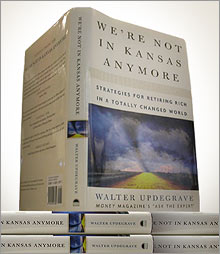|
Column Archive
Money Magazine Ask the Expert by Walter Updegrave
Hedge CDs, avoid interest rate sting
Nifty ladder strategy eliminates yield guesswork.
Sign up for the Ask the Expert e-mail newsletter NEW YORK (Money magazine) - I have $100,000 that I want to invest in CD's as part of my overall savings program. Please tell me how I should build a CD ladder based on your estimate of how interest rates will move over the next two to three years. -- Dennis, Wilmington, North Carolina
Wait a minute. The reason investors go with a laddering strategy with CDs or bonds in the first place is that they know it's virtually impossible to predict the future path of interest rates. Not even the mighty Greenspan, or Ben Bernanke, who will become his successor as Federal Reserve chairman next month, can do that. The beauty of laddering is that it allows you invest sensibly without making a prediction about -- or, more likely, a bet on -- where rates will go. It's much like diversifying your portfolio by buying many stocks, except that instead of spreading your money among different types of companies, you're hedging by investing in CDs or bonds with different yields and maturities. So, to my mind at least, the notion of basing your ladder on some guess about where rates might head over the next few years defeats the whole purpose of the strategy in the first place. I mean, if I really knew, for example, that long-term interest rates were going to head up significantly from here, I'd stick to very short-term CDs or money-market funds until I thought long-term rates had peaked, and then I'd move my money into long-term CDs. And if I thought the opposite was likely to happen, that long-term rates were headed down, I'd get into long-term CDs now to lock in higher rates. But since you can't know this stuff ahead of time, you do what investors have done for thousands of years to protect themselves against uncertainty: You hedge by diversifying. In the case of CDs, you can do that by building a simple ladder. Let's take your $100,000. You could split it up into five pieces, investing $20,000 in a one-year CD, another $20,000 in a two-year CD and so on up to a five-year CD, at which point you'll have invested your entire hundred grand. When the one-year CD matures, you invest the proceeds in a five-year CD, which leaves you with the same one- through five-year CD ladder you started with the year before. The advantage to this approach is twofold: You're always investing some, but not all, of your money at current rates. And you're less likely to make a decision based on emotion, such as putting all your dough into short-term CDs because you're convinced short-term rates are headed up. You can create variations of this ladder, going out to even longer maturity CDs or starting with three- or six-month CDs instead of one-year CDs. But the premise is basically the same. You spread your money around so that you own CDs along a broad spectrum of maturities and you regularly have some CDs maturing so you can reinvest at prevailing rates. (For more on how to build a ladder, click here) If you really, really want to try to factor the possible future direction of rates into your ladder -- say, keeping more of your money at the short-end of the ladder in the expectation that rates will rise -- you can check out the CD Rate Index Trend at Bankrate.com. There, you'll see what Bankrate's panel of experts think rates will do over the short and long term. I certainly don't mean to slight these experts, but I would be very wary about basing more than a smidgen of my investing strategy on such predictions. One final thing: Just because you're laddering doesn't mean you shouldn't care what yield you're getting on your CDs. Whatever the current level of rates, there are always some banks that are willing to pay more than others. And you can boost your portfolio's overall return by dealing with those institutions that are willing to shell out higher interest payments to get your money. To find the CDs of all maturities in your area with the highest yields, click here. ______________________________ For Ask the Expert's "She's a saver, he's a spender," click here
And for advice on stocks vs. funds, click here |
|


